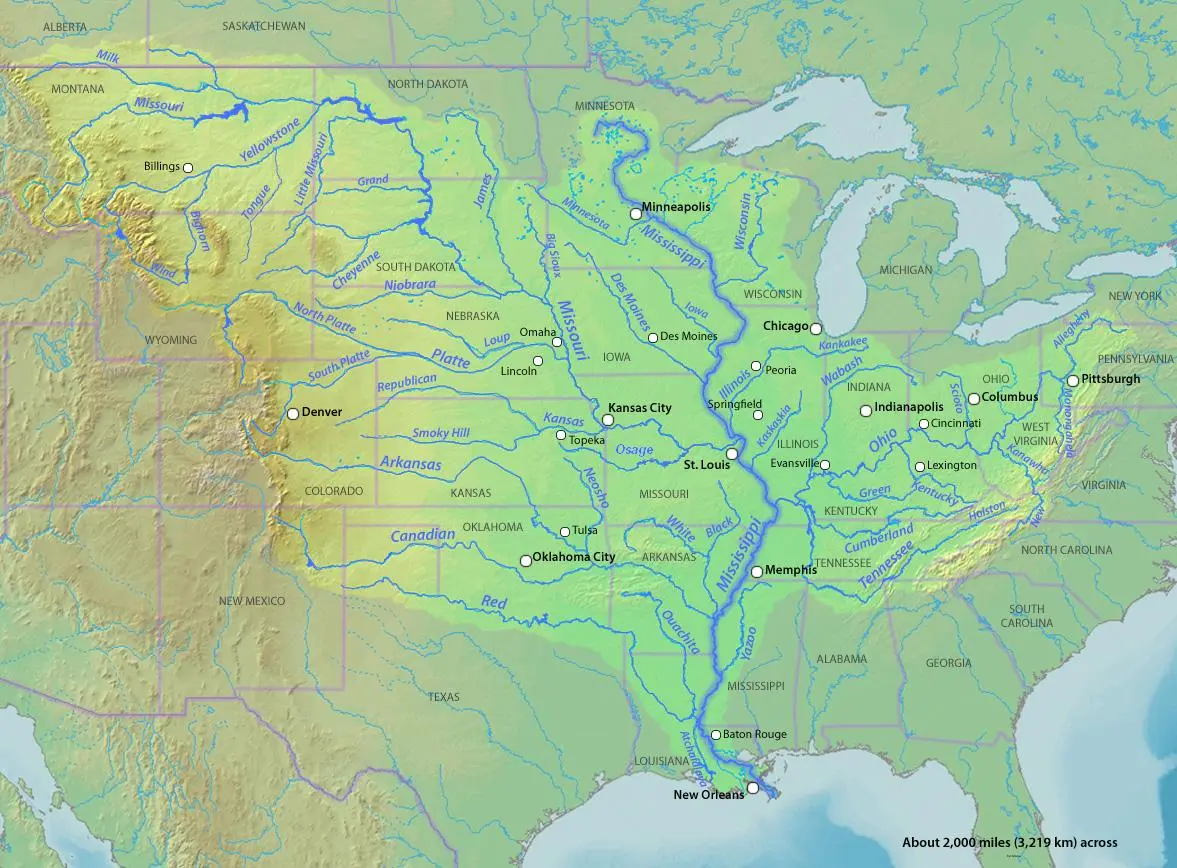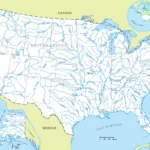Let’s dive into the flowing saga of the mighty Mississippi River! From its teeny tiny start in a Minnesota lake to its epic finale at the Gulf of Mexico, we’ll follow the river’s journey southward. Along the way, we’ll uncover the secrets of its water flow, the rocks it flows over, and the life that thrives in its waters. Get ready for a wild ride as we voyage 2,340 miles with the Mississippi, exploring the captivating world it shapes.
What Direction Does the Mississippi Flow?
Ever wondered which way the mighty Mississippi River goes? Well, it’s on a journey south! Think of it like this: picture a giant water slide starting way up north in Minnesota, at a spot called Lake Itasca. That’s where the Mississippi begins, and it’s ready to roll.
This isn’t just any river; it’s the second-longest in the US, stretching a whopping 2,340 miles. Along the way, it picks up even more water from other rivers like the Missouri and the Ohio, getting bigger and stronger as it goes.
It’s quite a trip as the Mississippi carves its way through the heart of America, eventually reaching its final destination: the Mississippi River Delta. That’s where it says goodbye to the land and empties into the Gulf of Mexico. And guess what? This entire epic journey happens entirely within the United States! The Mississippi’s impact is huge, too, as it drains the largest area of land in all of North America.
You can learn more about the geographical enigma of the rivers that flow north. The journey of River Nile has always been a topic of discussion. Get clarity about what direction does the Nile River run through the provided link. To know more about the rivers that flow north in the United States, venture into the world of how many rivers in the United States flow north.
In what direction does the Mississippi River flow?
Picking up where we left off, let’s talk about the direction of the Mississippi River’s flow. It journeys southward for a whopping 2,340 miles (that’s like driving across the entire United States!), starting from its humble beginnings at Lake Itasca in Minnesota and ending in the Gulf of Mexico.
Now, you might be thinking, “Okay, a river flows south, what’s so special about that?” Well, what makes the Mississippi unique is that it stays almost entirely within the United States. Most other major rivers in the world like to cross borders, but not our mighty Mississippi! This contained flow is a big deal because it means the river plays a vital role in the ecological, economic, and social landscape of the United States. It’s like the backbone of the country, connecting various regions and influencing everything from agriculture to transportation.
But why does the Mississippi flow south in the first place? Think of it like this: imagine you’re pouring water on a tilted surface. The water naturally flows downhill, right? It’s the same with rivers. The land around the Mississippi is higher at its source (Lake Itasca) and gradually slopes downward towards the Gulf of Mexico. This slope, called a gradient, creates a natural pathway for the water to follow, and gravity does the rest, pulling the water southward.
This southward journey isn’t just a sightseeing tour for the water; it has a huge impact on the surrounding environment. As the river flows, it carries with it nutrients, sediments, and organic matter, acting like a giant conveyor belt of life. These materials are deposited along the riverbanks, creating rich and fertile floodplains that are teeming with life. These floodplains become home to a remarkable diversity of plants and animals, making the Mississippi River a biodiversity hotspot.
To summarize:
- Flow direction: Southward
- Distance covered: Approximately 2,340 miles
- Uniqueness: Flows almost entirely within the United States
- Ecological impact: Creates fertile floodplains that support a wide variety of plant and animal life
- Factors influencing flow direction: Primarily the land’s topography, specifically the gradient (downward slope) from its source to its mouth. Gravity plays a key role as well, pulling the water downhill.
The Mississippi River: A Journey from North to South
Picture this: a drop of water, fresh from the sky, landing in the chilly north of Minnesota. That drop begins an epic journey south, all the way to the warm Gulf of Mexico. That’s the incredible voyage of the Mississippi River, and it’s all thanks to the simple but powerful force of gravity pulling it downhill.
Think of the land like a giant slide, gently sloping downwards. The Mississippi follows that slope, picking up speed and strength as it goes. Along the way, it’s joined by other rivers like the Missouri and Ohio, adding their own water to the mix. It’s like a family reunion, with everyone flowing together towards a common goal.
But this journey isn’t always smooth sailing. The Mississippi has been shaped and reshaped over eons by the earth itself. Ancient geological forces carved out its path, creating valleys and canyons that dictate its course. As if that weren’t enough, even we humans have gotten in on the act, building levees to control floods and dredging channels for navigation.
All of this – the gravity, the tributaries, the geology, even our own actions – comes together to create the mighty Mississippi as we know it. This flowing ribbon of life isn’t just a pretty sight, though. It’s the lifeblood of a whole ecosystem, providing a home for countless plants and animals that depend on its rhythm. From the tiniest fish to the tallest trees, they all owe their existence to the Mississippi’s southward flow. It’s a powerful reminder that everything in nature is connected, and even a simple drop of water can be part of something truly grand.
From Source to Sea: Tracing the Mississippi River’s Southern Course
The Mighty Mississippi keeps rolling along, its journey south as constant as the sunrise. We’ve already talked about where this incredible river begins, but now, let’s dive a little deeper into what makes the Mississippi tick, why it flows the way it does, and what that means for the folks who call it their neighbor.
Forces Shaping the Mississippi’s Flow
Imagine the Mississippi like a giant game of marbles, with the Earth itself as the game board. Gravity sets the rules: everything wants to move downwards. So, from its starting point in Minnesota, the Mississippi is naturally pulled south toward the Gulf of Mexico. But it’s not a straight shot! The land itself has a say in the matter too. The Mississippi’s path twists and turns, sometimes carving deep valleys and other times meandering across flat plains. And let’s not forget the tributaries, all those smaller rivers and streams that flow into the Mississippi like branches meeting the trunk of a mighty tree. They add their water to the mix, increasing the Mississippi’s power and sometimes even influencing which way it goes.
Human Settlements: A Dance with the River
For ages, people have been drawn to the Mississippi, its constant flow a source of life and opportunity. Long before Europeans arrived, Native American tribes built their communities along its banks, their lives deeply connected to its rhythms. Later, explorers used the Mississippi as a highway, venturing into the heart of the continent. And where the river met the sea, cities like New Orleans sprang up, their economies and cultures forever linked to the Mississippi’s ebb and flow. Even today, millions of people rely on the Mississippi for everything from drinking water to transportation.
The Future: A River’s Destiny
What does the future hold for the Mississippi? That’s the million-dollar question. Climate change is already shaking things up, causing more extreme weather like floods and droughts. These changes could affect the amount of water flowing in the river and even its course. And then there’s us humans. We’ve built dams and levees to control the Mississippi’s flow, but these interventions have consequences too. Will the Mississippi continue its southward journey as it always has? Or will we see changes in the years to come? Only time will tell.
Key Takeaways:
- The Mississippi River travels over 2,300 miles, originating in Minnesota and ending at the Gulf of Mexico.
- The river flows south due to the force of gravity, but its exact route is shaped by the land and the many tributaries that join it along the way.
- Throughout history, people have settled near the Mississippi, relying on it for resources and transportation.
- Climate change and human impact could potentially alter the Mississippi’s flow and direction in the future.
FAQ
Q1: In which direction does the Mississippi River flow?
A1: The Mississippi River generally flows south for 2,340 miles (3,766 km) from its source at Lake Itasca in northern Minnesota to the Mississippi River Delta in the Gulf of Mexico.
Q2: Why does the Mississippi River flow south?
A2: The Mississippi River flows south due to the force of gravity. Water flows downhill, and the Mississippi River is following the path of least resistance.
Q3: Are there any exceptions to the Mississippi River’s southward flow?
A3: Yes, there are a few exceptions to the Mississippi River’s southward flow. For example, the river flows west for a short distance near St. Louis, Missouri. Additionally, the river flows north for a short distance near Vicksburg, Mississippi.
Q4: What is the significance of the Mississippi River’s southward flow?
A4: The Mississippi River’s southward flow has played a major role in the history and development of the United States. The river has been a major transportation route and has helped to shape the country’s economy and culture.
Q5: What are the environmental challenges facing the Mississippi River?
A5: The Mississippi River faces a number of environmental challenges, including pollution, climate change, and invasive species. These challenges threaten the health of the river and its ecosystem.
- Senior at What Age: Benefits & Eligibility Guide - March 29, 2025
- Unlocking Senior Benefits: How Old is a Senior? Your Complete Guide - March 29, 2025
- Master Russian Politeness:A Guide to Saying Please - March 29, 2025
















